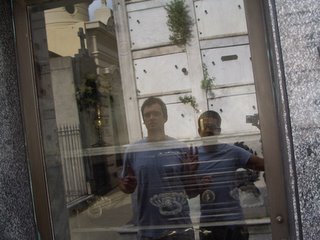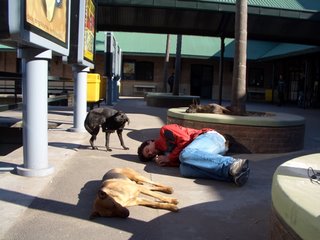Necrologistics

Last week I visited the famous cemetery of Recoleta with my trusty sidekick, the Nepalese healer Claxon Bajadi.
The cemetery is located in the center of Recoleta, one of the most exclusive neighborhoods of the capital. To the south and the west, a shopping mall and garish nightclubs peer over its tall walls. To the north and east, the balconies of gente de bien look over a fascinating city of the dead, whose ornate crypts line narrow allies, mimicking the density of the surrounding city. (Photos are soon to follow.)
As we made our way through the cemetery, I pointed out to Claxon some of the many historical figures that have come to rest in the marble structures whose dimensions are comparable to those of studio apartments in New York City. Behind iron grates and thick glass, we could often glimpse coffins stacked atop one another. Narrow stairways descend into darkness, suggesting the presence of many more inhabitants beneath our feet.
Claxon kept asking to see the tomb of Evita, so we headed towards where I thought it was.
Soon I realized we were lost. Reluctant to ask for directions, we zigzagged through the southwest corner of the cementerio.
Up against the wall, there was a crypt whose door was open. Inside, a woman in her mid-sixties was sweeping the floor. I stuck my head in the crypt, and asked if she would mind a few questions.
“Not at all,” she said.
It turned out to be her family crypt. The recently deceased occupied the niches on the ground level, the rest nap in the basement.
While we spoke she adjusted the lacy sheet covering her mother’s tomb.
“I come here every week,” she said. “I always talked to my mamita, and I won’t stop now.”
“Do you mind if I ask an indiscreet question?” I asked. I wanted to know how it was that all those bodies didn’t smell.
“The coffins are sealed in such a way that they don’t smell,” she explained.
Now it was her turn to ask a question. She wanted to know where we were from. We naturally confused her: I speak Spanish like a Berlitz tape, and my guess is she suspected Claxon was a Bolivian in designer clothing.
She welcomed us to her country, and then apologized.
“It’s a disaster,” she kept repeating. “Every time someone asks me where the tomb of that Eva Duarte is, I want to scream.”
“Why?” I asked innocently.
“She and her husband robbed this country. She walked around wearing diamonds, giving away things to the poor. This is an ignorant country. We have everything, but our country is a disaster.”
This rant continued for a few minutes until she shifted her sights to contemporary political figures. George Bush and Hugo Chávez, in her opinion, are idiot demagogues cut from the same cloth.
All the while, she rested her hand against her mother’s coffin.
As regular readers of this blog will note (see "What a Wonderful World It Would Be"), extemporaneous political opinions are as frequent in Argentina as steak and dulce de leche.
“Do you understand what I’m saying?” she asked Claxon finally.
Claxon smiled broadly.
We introduced ourselves, then said goodbye.
Now more than ever, we wanted to see the tomb of Evita.
I asked a maintenance man where we could find it. He looked at his feet and, without further hesitation, responded: “eleven aisles down, then to the left.”
I imagine that he must at all times keep track of his own position in the cemetery by measuring his distance from the tomb of Evita.



0 Comments:
Post a Comment
<< Home